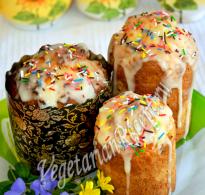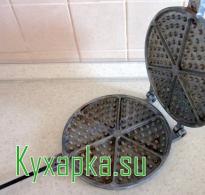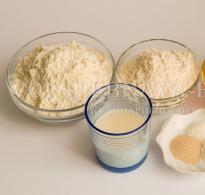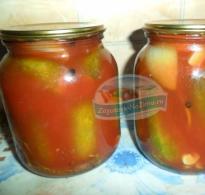Icing for Easter cakes is a technology for preparing sugar, protein, chocolate, and gelatin glazes that do not crumble. Delicious and quick cakes without yeast
Yesterday I told you how to do alexandrian dough for Easter cakes, and now I want to tell you how to prepare glaze for Easter cakes with gelatin. This is a rather unusual method, because there is no protein, and the consistency is completely different. This recipe for Easter cake icing is made with gelatin so that it does not crumble or stick. Some housewives replace sugar with powdered sugar; if you want, you can do the same. What this recipe sugar glaze for Easter cake without eggs is a big plus, because sometimes there is no extra protein, or you want to use it for another dessert, or someone is afraid to use it raw.
Decorating Easter cakes with your own hands is the most enjoyable activity in this whole process. My child helped me with this task; he really enjoyed decorating them. If you also have children, ask them for help and they will be happy to help. If you also want to know how to make Easter cakes, then look at the Alexandria dough, it makes them very tasty.
Ingredients:
- Sugar – 150 g
- Water – 6 tbsp
- Gelatin – 1 tsp
How to make icing for Easter cake
To prepare it, I take only three ingredients: sugar, water and gelatin.
 Next, pour gelatin into a small container and add 2 tablespoons of water to it. I give the gelatin time to swell, this will take no more than 5 minutes.
Next, pour gelatin into a small container and add 2 tablespoons of water to it. I give the gelatin time to swell, this will take no more than 5 minutes.
 Then pour sugar into a small saucepan and pour in the remaining water. I mix everything well and put it on fire. It is important that the sugar is completely dissolved. If desired, replace it with powder.
Then pour sugar into a small saucepan and pour in the remaining water. I mix everything well and put it on fire. It is important that the sugar is completely dissolved. If desired, replace it with powder.
 After the sugar has dissolved, add the swollen gelatin and mix.
After the sugar has dissolved, add the swollen gelatin and mix.
 The mass must be completely homogeneous. As you can see, the recipe for glaze for Easter cake is not complicated. I remove the saucepan from the heat. Next, I immediately begin whisking until the gelatin begins to harden.
The mass must be completely homogeneous. As you can see, the recipe for glaze for Easter cake is not complicated. I remove the saucepan from the heat. Next, I immediately begin whisking until the gelatin begins to harden.
 Now with a mixer at medium speed, beat everything until white foam and icing ready for Easter cake.
Now with a mixer at medium speed, beat everything until white foam and icing ready for Easter cake.
 Now about how to decorate Easter cake with your own hands. It is important not to think too long and do everything quickly. I dip the top of each cake into the glaze and make sure it evenly covers the top. As you can see, on the fourth of them you can already see that the consistency is thicker, and this is not very nice.
Now about how to decorate Easter cake with your own hands. It is important not to think too long and do everything quickly. I dip the top of each cake into the glaze and make sure it evenly covers the top. As you can see, on the fourth of them you can already see that the consistency is thicker, and this is not very nice.
 Then I decorate them on top with icing flowers and various confectionery toppings, figures, to suit your taste. Next, I set them aside to let the top dry.
Then I decorate them on top with icing flowers and various confectionery toppings, figures, to suit your taste. Next, I set them aside to let the top dry.
 This is the icing for Easter cakes with gelatin. I really liked her appearance. But you have to work quickly in order to decorate it, otherwise nothing will stick to it. So grab yourself an assistant and go ahead and experiment. Happy Easter!
This is the icing for Easter cakes with gelatin. I really liked her appearance. But you have to work quickly in order to decorate it, otherwise nothing will stick to it. So grab yourself an assistant and go ahead and experiment. Happy Easter!
Frosting for Easter cakes can be made in several ways. This could be egg white frosting, chocolate frosting, or eggless sugar frosting. Read this article for three options. step-by-step preparation icing for Easter cakes. Choose the option that you like the most. Let your Easter cakes be very tasty!
This is my favorite cake frosting recipe. This glaze is very simple to prepare; it turns out white, dense, dries quickly, does not stick, does not crumble or crumble. To prepare this glaze you will need:
- gelatin - 1 tsp.
- sugar - 1 tbsp.
- water - 6 tbsp.
Sugar glaze with gelatin: preparation.
1 tsp pour 2 tablespoons of gelatin cold water. Leave to swell.
Meanwhile, 1 tbsp. sugar pour 4 tbsp. water and place on low heat to cook sugar syrup. Cook until the sugar dissolves, be sure to stir so that the sugar does not burn.
When the sugar has dissolved, remove the syrup from the heat. Add the swollen gelatin to it and stir until the gelatin dissolves.

Now take a mixer and beat the resulting mixture until it becomes white and thick.

Apply this glaze to the cakes immediately as it hardens quickly. After the cake has been anointed, immediately pour in the decorations, since the gelatin has not done its job.
This glaze is beautiful, and will not crumble after a few days, will not crumble when cut, dries quickly, and does not need to be dried further.

Protein glaze with powdered sugar.
It is traditional to prepare sugar icing for Easter cakes from egg whites and sugar. You can also make this glaze using this recipe. For the white glaze you will need:
- egg white - 1 pc.
- powdered sugar - half a cup (can be replaced with sugar, but powder is better)
- lemon juice - 1 tbsp. (can be replaced by citric acid on the tip of a knife)
- salt - a pinch
- vanillin or vanilla sugar- optional for flavor
How to make frosting with egg white and powdered sugar.
Separate the white from the yolk. Add a pinch of salt to the protein and beat with a mixer for 1 minute. A thin foam should appear.
Now add it to the egg white powdered sugar(half a glass, or 60 gr.) and pour in lemon juice (1 tbsp.).

Using a mixer at high speed, beat the egg whites with powder until thick foam. Cover the cakes with this glaze and decorate to your taste. If you want the icing not to stick, put the cakes in the oven for a couple of minutes so that the whites dry out.

Chocolate icing for Easter cake.
If you want to add a little variety to your cakes, you can make chocolate glaze. It is done very simply and quickly.
Take milk or dark chocolate without additives and butter. Proportions 1:1. That is, per 100 gr. you need 100 grams of chocolate. oils
Break the chocolate into pieces and melt in the microwave or in a water bath. Soft butter(you need to remove it from the refrigerator in advance!) add to soft chocolate, stir. And again melt everything together until it forms homogeneous mass. That's it, the glaze is ready!

Wait until the glaze cools and becomes thicker. After this, you can apply it to the cakes. You can decorate with grated chocolate and orange zest or Easter cake sprinkles.

Bake Easter cakes with love! Happy Easter to you!
Ingredients:
- sugar - 200 grams;
- instant gelatin - 6 grams;
- water - 90 milliliters;
- lemon juice - 2-3 drops.
Glaze for Easter cakes with gelatin. Step by step recipe
- Pour gelatin with 2 tablespoons of water, stir and leave to swell for approximately 15-25 minutes.
- Pour sugar into a separate saucepan, pour in the remaining water, mix well and put on fire.
- Bring to a boil and cook, stirring until the sugar is completely dissolved.
- Remove from heat, add the swollen gelatin (no need to melt it) and mix well with a spoon.
- Next, beat the still hot syrup with a mixer at high speed until a white thick foam appears. This will take approximately 3-4 minutes.
- Leave to cool slightly - until warm - approximately 10 minutes.
- Add a few drops lemon juice(can be replaced with orange if desired), you can also add food coloring at this stage. And beat again for about 1 minute.
White sugar icing for Easter cakes with gelatin is ready! Apply it immediately after preparation: it hardens quite quickly. Another very important thing: apply the glaze to already completely cooled cakes - this ensures their correct texture, without drying out or streaking (since sugar tends to melt). This fondant can be used not only for Easter cakes: I used it to make cupcakes, pour over rolls and even eclairs - my child simply adores it.
Ingredients:
- eggs - 3-4 pieces;
- milk - 150 grams;
- sugar - 150 grams;
- raisins - 100 grams;
- flour - 500 grams;
- cream margarine - 200 grams;
- vanilla sugar (vanillin) - 1 sachet (8-10 grams);
- baking powder - 10 grams;
- sugar icing with jelly;
- sprinkles - optional.
Delicious and quick cakes without yeast. Step by step recipe
- Softened cream margarine transfer to a bowl, add sugar, vanillin and beat with a mixer until fluffy and buttery.
- Add eggs one at a time and beat until creamy and smooth.
- Add baking powder while continuing to beat with the mixer.
- Pour in milk room temperature, stir everything a little and then lightly beat.
If you immediately turn on the mixer at high speed, the milk will splash all over your kitchen.
- Sift the flour and add it into the dough in small portions - it should turn out a little thicker than sour cream. Since everyone’s flour is different, try to focus on the sour cream consistency of the dough itself.
- We prepare the raisins in advance: rinse under running water, dry on a paper towel. If your raisins are too dry, then leave them in water for 15-20 minutes, and only then dry them.
- Add approximately 0.5 tablespoon of flour to a bowl with clean and dry raisins and mix well. We need to roll each raisin - this is done so that the raisins do not settle in the dough.
- Pour the raisins into the dough and mix well with a spatula. The dough will become a little thicker, but the consistency still allows you to knead with a spoon or spatula.
- Grease clean, dry baking pans vegetable oil and fill with dough: it should take up a little more than half of the mold.
- Place in the oven for 35-40 minutes at 200 degrees. On the bottom of the oven I always place a bowl of hot water to prevent the cakes from burning.
Ready and completely cooled Easter cakes brush with our freshly made gelatin sugar glaze. If desired, you can decorate with colored sprinkles. And my child loves to sprinkle the top of the cakes with crushed nuts. I'll be honest - it turns out very tasty and cute! Join us for “I Love to Cook” - we have many more delicious and easy Easter recipes!
Hello everyone!
Are you hungry for new recipes? Sure enough, I immediately scribbled down a whole post with delicious, proven recipes for fudge for Easter baking. Oh, well, without her, Easter cake isn’t even Easter cake. Do you agree? The glaze, all so tender, airy and sweet, beautifully covers the very top of the Easter products.
You can, of course, not be particularly religious. But, who forgot, I remind you that we are very much preparing for the big Happy Holidays. Already stocked up. We also replenished our culinary collection with amazing
That’s why today we’re talking about it – icing. Looking ahead, I will say that the ingredients required for its production are at most 3-4 and all these products are always available at home. The process itself also takes a little time - 15-20 minutes. True, it can take a long time to dry. But even then not for all recipes. There are options that you don’t need to yawn, but immediately spread on baked goods.
Well, we use the fondant itself not only for Easter cakes, but also to cover gingerbread cookies. To do this, we glaze from special pastry bags.
How to make icing for Easter cake so it doesn't crumble
This glaze with gelatin and lemon juice will never crumble in your baked goods. And when cut, it remains smooth without any cracks. For these qualities, as well as for its pleasant sour-sweet taste, many chefs love it.

It is important to know that our ideal fondant dries very quickly and will not wait for you to bake your products. Therefore, before you start preparing it, the pasochki must already be baked and cooled.
I also recommend buying fresh gelatin rather than using last year’s. Then he behaves as we need.
We need:
- Water - 6 tbsp. spoon;
- Gelatin - 1 teaspoon;
- Sugar - 200 grams;
- Lemon juice - 7-8 drops.
Preparation:
1. Pour gelatin with 2 tablespoons of cool water and set aside to swell.

2. While it is swelling there, pour all the sugar into a small saucepan and fill it with the remaining water. Stir the mixture until all the sugar is wet. You may want to add more water, but it's better not to - this amount is quite enough.
3. Place the saucepan on slow fire and cook, stirring continuously. We need to cook sugar syrup. When it is all dissolved, the syrup is ready.

4. Cool it for no more than 5-6 minutes and immediately add the swollen gelatin. Stir quickly until the mixture becomes viscous.

5. Take out the mixer and start whipping the syrup at the highest speed. It should turn white in just three minutes.
6. Now add 7-8 drops of lemon juice, continuing to beat the mass. If you want it sour, pour more. And also, if desired, you can add 1-2 tablespoons of cocoa powder and then the glaze will turn out chocolate.

7. In 20 minutes the fondant can completely harden. Therefore, without delay, let's start covering. To do this, dip the Easter cakes directly into the saucepan and turn them in a circle. Do everything carefully, trying not to drown all the baked goods.
Well, in 15-20 minutes Easter baking can be served.
The Easter cakes turned out to be a sight to behold under the fluffy snow-white cap. We eat with pleasure!
Recipe for Easter fudge made from protein and sugar
I think this is the most popular and classic frosting we know. But sometimes we just forget how many ingredients we need to put in, and that’s why we immediately look for a recipe. Another reason is that egg whites don’t always want to whip into a very thick foam. And without thick foam, there will be no beautiful snow-white caps on the Easter cakes.

But it’s good that there are recipes that take into account all the nuances. Therefore, if everything is done according to technology, the result is always joyful and satisfies any housewife. Let's look at the detailed recipe.
Required products:
- Egg - 2 pieces;
- Powdered sugar - 200 grams;
- Lemon juice - 2 tablespoons.
Preparation:
1. Carefully separate the whites from the yolks into a glass bowl. We do everything very carefully, because an extra drop of yolk in the whites can ruin everything. Immediately prepare more lemon juice and powdered sugar.
2. Place the bowl in the refrigerator for 30 minutes. Well-chilled egg whites whip better.
3. Take out the whites after the time has elapsed and begin to beat with a mixer until light foam. While still working with the mixer, add lemon juice. Beat and add powdered sugar in small portions.
4. Beat the entire mass at medium speed until strong peaks appear. This fudge does not drip from the mixer beaters. You can already cover the tops of Easter cakes with it.
This glaze will keep for 1-2 hours in the refrigerator. And it can harden on products for several hours. Therefore, do not cover the baked goods with a towel until they are completely dry.
5. Spread snow-white fluffy foam on top of the baked goods and decorate with different confectionery decorations. This could be multi-colored sprinkles, grated chocolate, colorful wafer leaves.
You can show your imagination and color the already hardened hats with pastry pencils.

In general, it’s all about your imagination and good mood!
And then we serve pasochki for tea. Bon appetit!
An interesting way to make glaze with milk
I also liked the very tasty one with milk. The preparation time takes no more than 5 minutes and a mixer is not needed at all. And the fondant itself turns out white-transparent, shiny and tastes pleasantly milky. It also freezes with a bang! Let's watch a visual video.
A simple option for glazing Easter cakes with gelatin
Here we will consider the simplest version of fudge with only three ingredients. And for everything to work out, it is important to strictly follow the recipe. And then it turns out simple perfect option! It does not crumble or spread, which is what all housewives like so much.

We need:
- Gelatin - 0.5 teaspoon;
- Sugar or powdered sugar - 100 grams;
- Clean water - 3 tbsp. spoons.
Preparation:
1. Mix half a teaspoon of gelatin with 1 tablespoon of hot water, but not boiling water. Stir and stir until dissolved and transparent.

2. In a saucepan, combine 100 grams of sugar with the rest of the water and cook over heat until completely dissolved. At the same time, stir vigorously with a spoon all the time.
Many housewives use powdered sugar instead of sugar. It dissolves faster and does not leave any grains in the fondant.
3. Pour in the gelatin mass in a thin stream and stir until smooth.

4. Remove the saucepan from the heat. We need to cool it down. When it cools down and becomes warm, beat with a mixer into a thick, viscous mass.
6. Therefore, cover with a thin layer and immediately use colored confectionery sprinkles.

As you can see, there is nothing complicated in the process. Sometimes the icing may fail, but this happens in very rare cases and depends on the quality of the sugar or gelatin. Therefore, experiment in advance so that you can delight your family and friends with magnificent glazed pastries.
Awesome chocolate fudge with cocoa
Why not cover the cakes with chocolate deliciousness? We all love chocolate, so we’ll use it here. Moreover, the recipe is simple, everyone can do it. And then the result will delight you with its profound chocolate taste and a mirror surface.

Required products:
- Butter - 50 grams;
- Sugar - 100 grams;
- Cocoa powder - 50 grams.
Preparation:
1. Take a saucepan with a thick bottom. Add sugar, cocoa powder and 50 grams of water. Place on the fire and, stirring, bring to a boil.

2. Dissolve the butter in the chocolate mixture and remove from heat.

3. Cool slightly and glaze the beans, pouring on top. We decorate to your taste. Let the brown fudge harden and the delicacy can be eaten with family and friends.
Enjoy your meal!
Colorful beauty recipe for covering Easter cakes
I was inspired last Easter and I created absolutely masterpieces! Well, in my opinion this is true, but you can argue and criticize. I will not be offended. And if you like it, follow the simple recipe.

We take as a basis protein glaze. I described the cooking method at the beginning of the note, so prepare it first. We will also need dry food coloring. At that time I had green, red and blue colors.
Cocoa will also give a beautiful and tasty shade. You can put about 0.5-1 teaspoon of the product into the fondant.
We put our fondant in different bowls so we can paint each one a different color. Pour the dye literally onto the tip of a teaspoon and immediately mix using a mixer.
Here I painted it soft pink color, adding a little red paint.

Here I ended up with a soft blue, like the color of the sky. I liked this shade the most and I applied it to large Easter cakes.


Then I decorated some of the baked goods with colored sprinkles, some with sesame seeds, some with poppy seeds and even waffle flowers.
Bottom line: you can use different food colorings, just try not to overdo it. Let the colors be gentle and not very bright. The fondant hardens over time in the same way as uncolored. That is, it may take 10-12 hours until it hardens completely.
Today I have everything. Do you have any questions? Feel free to ask them below in the comments. And also share useful tips on social networks with friends.
A distinctive feature of this glaze, which is suitable for covering not only Easter cakes, but also other homemade baked goods, we can call the presence of gelatin. I used instant - it needs to be immediately dissolved in hot water. If you have gelatin that needs to be soaked, fill it in advance cold water and leave for 30 minutes. When the gelatin swells, heat until completely dissolved, without bringing to a boil.
Another very important point: You have to work pretty quickly with this sugar icing. The fact is that the gelatin in its composition quickly sets and the glaze begins to harden. At the same time, if you do not allow it to thicken enough, the coating will turn out thin and transparent. In general, try it and maybe gelatin sugar glaze will become your favorite.
Ingredients:
Cooking the dish step by step with photos:


I wrote above about choosing gelatin, so carefully read the instructions on the package. So, take 1 teaspoon of instant gelatin (this is about 3-4 grams) and fill it with 2 tablespoons of very hot (80-90 degrees) water.

Mix thoroughly until all the grains are completely dispersed. If the liquid is cooling and the gelatin has not yet completely dissolved, you can warm everything up a little in the microwave. Important: gelatin cannot be boiled, otherwise it will lose its gelling properties!


We bet on medium heat and, stirring, bring to a boil. We need all the sugar to dissolve. There is no need to boil the syrup further.

Pour over hot gelatin into hot sugar syrup. To make sure there are no undissolved gelatin crystals left, it is best to use a strainer.

All that remains is to beat the sugar syrup with gelatin with a mixer at medium speed. When the mixture becomes foamy, add a teaspoon of lemon juice and continue beating the future glaze at high speed.

How long should you beat this glaze? The time depends on the power of your electric assistant. You decide when you need to stop: when whipping, the sugar syrup will thicken quite quickly, acquiring the required consistency. I decided to stop at the stage where the gelatin glaze resembled regular egg white glaze. That is, it flows off the spoon like a thick thread.






